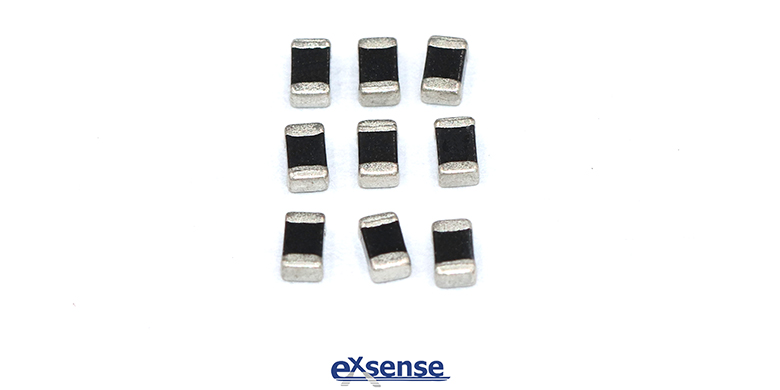
NTC thermistor is highly used in automotive, household appliances, medical devices and other fields because of its high accuracy, low price and great reliability. Today, the high-precision high-power SMD NTC thermistor EXSENSE electronics introduce, its surface electrode-type design, thin and dense glass surface encapsulated technology, increase the dissipation coefficient, improve the resistance of thermistor to harsh environments (tide, salt spray, etc.). The wide-strip cutting-up process allows for more precise adjustment of resistance values and improves the electrical performance of high-precision high-power NTC thermistor.
The technological process of high-precision high-power SMD NTC thermistor: substrate preparation - printing/sintering surface electrode - cutting-up - resistivity test - slicing - glass encapsulation - electrode printing - test sorting - taping - packaging. The specific process is as follows:
1, substrate preparation
According to the formula porcelain powder: PVB adhesive:organic solvent=100: 40: 60 ratio, and place in the ball grinding tank for 20 hours, then use isostatic pressure molding method, the prepared NTC thermosensitive ceramic powder placed in a rubber mold, put it into the static press after loose, compact by vibration, press at 300~400MPA for 30 minutes. After release pressure, remove the made ceramic ingots from the mold, then slice (according to the designed requirements of NTC thermistor, use inner circle cutter, the sintered ceramic ingots cut into the required thickness of the substrate (200-2000μm), then through tape-ranked and sintering to make NTC thermosensitive ceramic substrate.
2, printing - sintering surface electrode
On the upper and lower sides of the substrate, the superposition surface electrode was obtained by screen printing, and the silver electrode was sintered in the burned silver furnace.
3, cutting up
On the substrate coated with the glassed encapsulated layer, according to the dislocation of the upper and lower surface electrodes, cut it into wide-length strips, get the NTC thermistor strip with the dislocation electrode on upper and lower sides, then use the outer circle cutter to cut the substrate into strips, the width of the long strip is equal to the length of the chip-type thermistor required to be prepared.
4, resistivity test
The resistivity test of the wide strip is accurately calculated for the size of the required resistance value, and its resistivity can be mastered by testing the electrical performance of the wide bar.
5, slicing and dicing
Slicing: According to the size calculated by the resistivity test, the wide-length strip is precisely sliced into pieces to obtain a single NTC thermistor chip with an interlaced electrode on upper and lower sides. (At this point, the surface and bottom of striped are covered by a glassed encapsulated layer.)
Scratch: Through the mastered resistivity, the chip size corresponding to the required resistance value can be calculated accurately. In this way, the wide-length strip can be precisely cut into the square slices with the required electrical properties to achieve the high-precision resistance value control.
6, glassed encapsulation
The four sides of the square slice are coated with glass slurry (except the electrode) by spraying method, and then the coated glass of surface was sintered.
Surface glass slurry coating: The surface was coated with a glass slurry of 10~50μm by dip coating method, spray method or printing, and then sintered to obtain a functional ceramic substrate with a dense glass layer of 10~30μm on upper and lower sides.
Side glass slurry coating: First, the glass slurry is sprayed from one end to the other end of the carrier plate, which is arranged as a whole plate element. After spraying one side, reverse the load plate 180° and spray the other side. Next, place the whole plate element, which is coated on both sides, in the oven and take appropriate temperature and time to bake and dry.
Sintering: The chip components coated with the glass slurry are sintered in the mesh-belt sintering furnace or box-type sintering furnace, so that the side glass slurry layer forms a dense glass protective layer, and the thickness of the glass encapsulation layer is controlled at 10~30μm. Thus, a dense glass protective layer(except the two end faces) is formed on all four sides of the chip thermistor.
7, electrode printing
The end sealing device is used to coat the electrode slurry on both ends of the square slice and sintering.
Three - layer electroplating of terminal electrode: The electrode slurry was evenly coated on both ends of the chip by dip method and sintered by electrode metal reduction process. Then, a layer of Ni and a layer of Sn were electroplated on the surface of the terminal electrode by chemical electroplating method, so that it has good welding performance and fully meets the welding requirements of the surface mount process. The chip thermistor with glass encapsulation has excellent resistance to acid, alkali and moisture, which can obtain thick enough end electrode coating in the electroplating process, without worrying about the phenomenon of coating creep caused by the conductivity of the porcelain body of thermistor. At the same time, due to the protection of the tight glass packaging layer, thermistors also have high reliability and stability in the process during working.
The high-precision high-power SMD NTC thermistor produced by EXSENSE Electronics Technology Co., Ltd. production, in the premise of ensuring insulation strength and moisture resistance, it is very beneficial to the internal dissipated heat emission, which improves the current capacity and reliability of thermistor.



